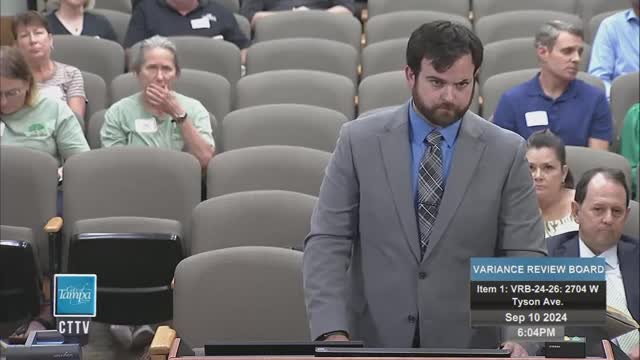Tree Removal Sparks Controversy Over Construction Plans
September 13, 2024 | Tampa, Hillsborough County, Florida
This article was created by AI summarizing key points discussed. AI makes mistakes, so for full details and context, please refer to the video of the full meeting. Please report any errors so we can fix them. Report an error »

In a recent government meeting, discussions centered around the potential removal of a large limb from a significant tree located on a residential property. The limb, measuring 14 feet 3 inches, poses challenges for both the tree's health and the construction of a new driveway. Experts evaluated whether the limb could be safely removed without causing serious damage to the tree, concluding that while the tree could survive the removal, the combined effects of limb and canopy loss, alongside construction activities, could jeopardize its long-term health.
The arborist's report indicated that the tree's location and the necessary construction work would likely lead to root compaction and canopy loss, which are detrimental to the tree's vitality. Typically, a buffer of 10 feet from the trunk is recommended for construction activities, but the proposed plans would encroach on this guideline, complicating access and potentially harming the tree.
Further complicating matters, the discussions revealed that the construction process would require equipment that may not fit under the tree's canopy, risking damage to the tree if not managed carefully. The arborist noted that while a tree of this size could tolerate a canopy loss of about 25%, the proposed construction activities would likely exceed this threshold, necessitating significant trimming that could further stress the tree.
The meeting underscored the delicate balance between development and environmental preservation, highlighting the need for careful planning to mitigate impacts on the tree while accommodating construction requirements. As the project moves forward, stakeholders will need to consider alternative strategies to protect the tree and ensure compliance with local regulations regarding tree preservation.
The arborist's report indicated that the tree's location and the necessary construction work would likely lead to root compaction and canopy loss, which are detrimental to the tree's vitality. Typically, a buffer of 10 feet from the trunk is recommended for construction activities, but the proposed plans would encroach on this guideline, complicating access and potentially harming the tree.
Further complicating matters, the discussions revealed that the construction process would require equipment that may not fit under the tree's canopy, risking damage to the tree if not managed carefully. The arborist noted that while a tree of this size could tolerate a canopy loss of about 25%, the proposed construction activities would likely exceed this threshold, necessitating significant trimming that could further stress the tree.
The meeting underscored the delicate balance between development and environmental preservation, highlighting the need for careful planning to mitigate impacts on the tree while accommodating construction requirements. As the project moves forward, stakeholders will need to consider alternative strategies to protect the tree and ensure compliance with local regulations regarding tree preservation.
Don't Miss a Word: See the Full Meeting!
Go beyond summaries. Unlock every video, transcript, and key insight with a Founder Membership.
✓
Get instant access to full meeting videos
✓
Search and clip any phrase from complete transcripts
✓
Receive AI-powered summaries & custom alerts
✓
Enjoy lifetime, unrestricted access to government data
30-day money-back guarantee
